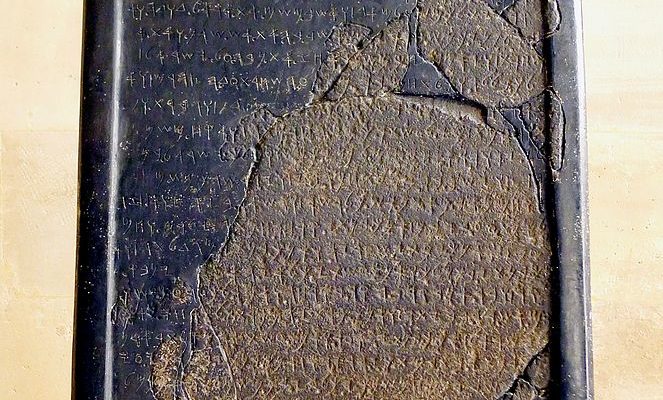The full text of the Mesha Stele’s glorification of a Moabite victory over the “House of David” was discovered through the use of a computer imaging technique.
By Batya Jerenberg, World Israel News
A slab of stone bearing a long description of a Moabite war against ancient Israel that mentions the “House of David” was recently translated in full thanks to a computer-imaging technique, adding archeological proof to the Bible’s description of the Jewish kingdom that flourished in Israel some 3,000 years ago.
The Mesha Stele, also known as the Moabite Stone, consists of 33 mostly-legible lines of text that describe the exploits of King Mesha of Moab, who ruled in the ninth century BCE where modern Jordan is today.
It references how Mesha defeated the son of Omri, a “king of Israel,” after both father and son had “oppressed Moab” for many years, and took back Moabite cities that the Jewish king had fortified.
In the latest issue of Biblical Archeology Review, two researchers, André Lemaire and Jean-Philippe Delorme, explained how they confirmed that damaged lettering in the stele contained the phrase “House of David” to specifically name the Moabite king’s enemy.
They used a method called Reflectance Transformation Imaging. Invented in 2001, it digitally photographs an object multiple times, each time with light projected from a different direction. When combined, “the changing interplay of light and dark discloses fine details of the surface” and “reveal[s] surface information invisible under normal examination,” according to UK-based Wessex Archaeology, which uses the technique in providing archeological services.
The Second Book of Kings tells of a war between “Mesha, king of Moab,” and an alliance between the kingdoms of Israel and Judah. Judah was known as the House of David, after the Davidic dynasty that ruled the smaller of the two Jewish realms that shared the land of Israel for a few hundred years.
It differs in the result of the war, saying that the Israelite king, Joram – the grandson of Omri – defeated the Moabites as a result of a Divine miracle.
The stele also contains the earliest firm, extrabiblical reference to the Israelite god (YHWH), in context of Mesha bringing “his vessels” to his own Moabite god after he killed the whole population of an Israelite city named Nebo.
Nebo is mentioned in the Book of Numbers as a city built by the tribe of Reuben in the territory across the Jordan River from Israel.
The stone, measuring 1.15 meters high and some 60 centimeters wide, was discovered in 1868 in the ancient city of Dhiban in Jordan. Luckily, a paper-mache impression was made of it, because a year later it was smashed into several pieces by Bedouins who did not want it given to Germany by the Ottoman authorities.
Several of the fragments were found by a French archeologist, Charles Simon Clermont-Ganneau, and in 1877 he rebuilt the stele with a mixture of the original stones and the preserved lettering on the paper-mache.
The reconstructed slab is on display at the Louvre Museum in Paris. The Oriental Institute at the University of Chicago houses a copy.





